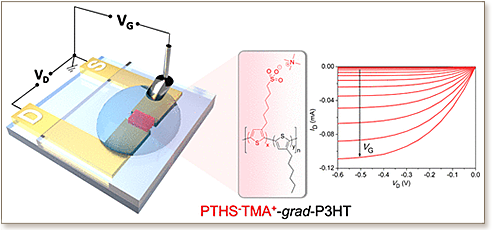

A new generation of polythiophene-based polyelectrolytes is reported to address fundamental issues in organic electrochemical transistors (OECTs). In such devices, the semiconductor must be able to transport and store ions and possess simultaneously a very high electronic mobility. For this, the ion-conducting 6-(thiophen-3-yl) hexane-1-sulfonate tetramethylammonium monomer (THS–TMA+) is copolymerized with the hole-conducting 3-hexylthiophene (3HT) to obtain copolymers, PTHS–TMA+-co-P3HT 1–3 with a gradient architecture. The copolymers having up to 50 mol % 3HT content are easily oxidizable and are crystalline. Consequently, for the copolymers, a higher stability in water is achieved, thus reducing the amount of cross-linker needed to stabilize the film. Furthermore, OECTs using copolymers with 75 and 50 mol % of PTHS–TMA+ content exhibit 2–3 orders of magnitude higher ON/OFF ratio and an extremely lower threshold voltage (−0.15 V) compared to PTHS–TMA+. Additionally, high volumetric capacitance (C* > 100 F/cm3) is achieved, indicating that the ion transport is not hampered by the hydrophobic 3HT up to 50 mol %, for which a very high OECT hole mobility of 0.017 cm2/(V s) is also achieved. Thus, the concept of copolymerization to combine both ionic and electronic charge transport in an organic mixed conductor offers an elegant approach to obtain high-performance OECT materials.
DOI: 10.1021/acs.chemmater.9b01722

"KAUST shall be a beacon for peace, hope and reconciliation, and shall serve the people of the Kingdom and the world."
King Abdullah bin Abdulaziz Al Saud, 1924 – 2015
Thuwal 23955-6900, Kingdom of Saudi Arabia
© King Abdullah University of Science and Technology. All rights reserved